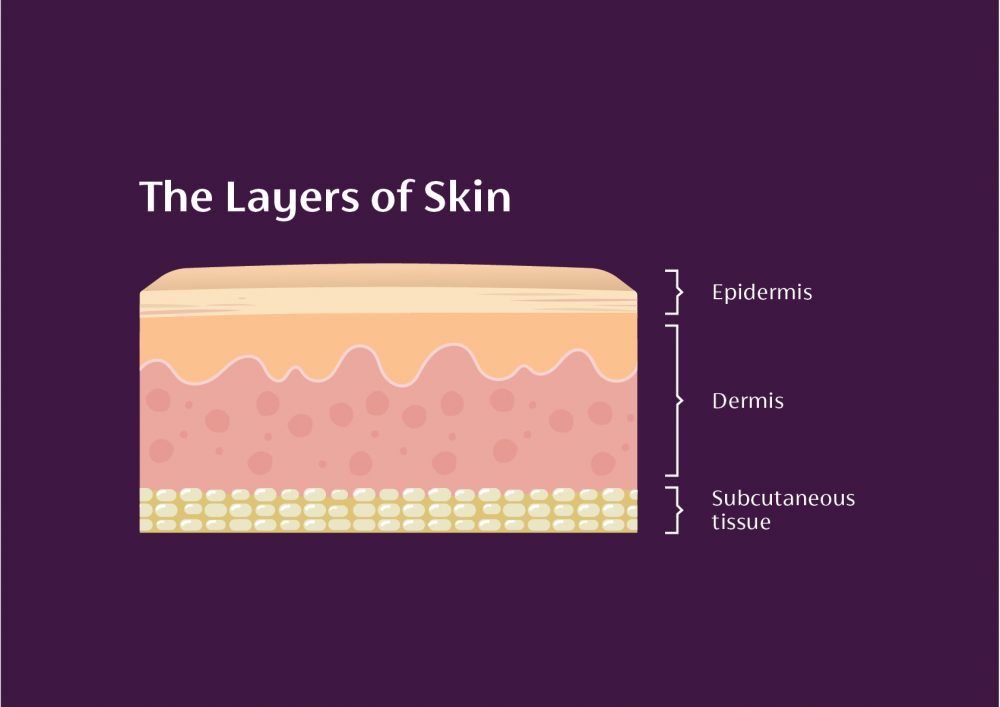
A scar changes a little every day – the sooner you start treating it, the more effective the healing. The answer to how to reduce the visibility of scars starts at understanding why our bodies create them in the first place.
In this article:
A scar is the body’s natural way of healing and replacing lost or damaged skin. Human skin is composed of three main layers: the outermost called the epidermis, the mid layer called the dermis and the innermost layer named hypodermis or subcutis [1] . In case of skin injury, a scar will form as the natural consequence of the healing process and wound closure.


Skin wound closure follows 3 steps: inflammation, proliferation and remodeling. Scar formation occurs during the remodeling phase that takes place after about 2 to 3 weeks when the wound is completely closed. During this remodeling process, collagen fibers will be recruited to the site of the injury, forming a scar that will feel and look different than the surrounding tissue.
Usually, collagen is good for your skin but the excessive amount of disorganized collagen, in addition to the lack of elastic fibers, is the reason for scar formation [1] . Over the counter products such as Mederma® scar treatment range possess moisturizing properties that limit water loss and, consequently, scar formation.
Skin conditions that seem minor, such as acne, may injure your dermis and cause scarring. The sooner you start treating them, the more effective the treatment.
There are 5 different types of scars:





Once formed, it’s hard to get rid of the scars. However, solutions exist to improve their appearance and make them fade away. Depending on the size and depth of your scar some treatments might be more effective than others.
Topical treatments: many topical treatments are available, especially for light scars, and include easy-to-access, over-the-counter creams and solutions containing FDA-approved ingredients such as:
Topical treatment may also include natural extracts to provide appearance/cosmetic effects. Those natural extracts include:
Other topical treatments contain pharmaceutical compounds and therefore are prescription only medicines. These include:
These topical treatments have shown some effectiveness in improving the appearance and feel of scars [8] . The sooner you start treating your scar, the more effective these treatments. The course of these treatments spans several months, but with patience and perseverance, your efforts will likely pay off.
For larger or more visible scars, you’ll probably need a more intense treatment that can only be done by a healthcare professional. These treatments are more invasive and include dermabrasion, laser treatment, micro needling, cryotherapy and filler therapy. They are not at-home treatments and require an expert opinion, so before starting any of these treatment, please choose your dermatologist carefully.
Mederma® Advanced Scar GelUsually, collagen is good for your skin but the excessive amount of disorganized collagen, in addition to the lack of elastic fibers, is the reason for scar formation
Usually, collagen is good for your skin but the excessive amount of disorganized collagen, in addition to the lack of elastic fibers, is the reason for scar formation
You cannot avoid all scars, but you can do many things to improve how a scar looks. You can also prevent scars by taking steps to prevent injuries and other damage to your skin. Some injuries will make a good story and you might even be proud of some of your scars but for others, you may want them to fade away.
Taking good care of a skin injury helps a lot in preventing scar formation, so it is important to always keep the wound moist and clean [9] . For acne pimples, refrain from squeezing, popping or picking them. In case of a cut, if the wound is deep or serious please go see your doctor immediately as you may require stitches for your injury to heal properly.
Once the wound has healed, keeping your scar moisturized is important. It is also important to keep the scar protected from the sun after healing, to avoid additional damages due to UVA and B [9] .
In short, skin injuries are nearly inevitable but taking good care of your injuries and starting early treatment can help reduce scar formation. Mederma® has a range of scar treatment products for adults and kids that have clinically shown to improve the overall appearance, color and texture of scars [10,11] .